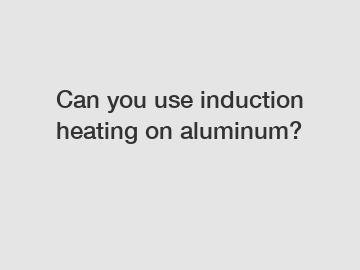Can you use induction heating on aluminum?
Induction heating is a fascinating technology that has revolutionized various industries, offering efficient and precise heating solutions. Different materials respond differently to this advanced heating technique, prompting the question: Can you use induction heating on aluminum? In this blog, we will explore the incredible capabilities of induction heating on aluminum and shed light on its applications, advantages, and considerations.
Understanding Induction Heating:
Before delving into the topic, let's grasp the concept of induction heating. It is a non-contact, rapid heating process that involves generating eddy currents within a conductive material by subjecting it to an alternating magnetic field. The eddy currents generate heat through electrical resistance, resulting in localized and controlled heating exactly where it is needed.

The Compatibility of Aluminum with Induction Heating:
Aluminum, being a non-magnetic metal, poses unique challenges when it comes to induction heating. Unlike ferrous metals such as iron or steel, aluminum does not exhibit efficient magnetic coupling to the alternating magnetic field. However, with the right setup and process optimization, induction heating can be successfully employed for aluminum.
Optimizing the Induction Heating Process for Aluminum:
1. Frequency Selection: The frequency of the alternating magnetic field plays a crucial role in ensuring effective induction heating of aluminum. Generally, lower frequencies tend to produce better results, as they allow deeper penetration of the eddy currents into the material.
2. Power Density Control: Adjusting the power density helps to regulate the heating rate and temperature uniformity. High power densities may result in surface overheating, whereas low power densities may lead to inefficient heating. Finding the perfect balance ensures the desired outcome.
3. Coil Design: Tailoring the coil design to the specific aluminum component or workpiece is essential. The shape, position, and winding configuration of the coil greatly influence the efficiency and effectiveness of induction heating for aluminum.
Applications of Induction Heating on Aluminum:
1. Thermal Forming: Induction heating is extensively used for thermal forming processes on aluminum, like bending and shaping, as it offers rapid, controlled, and localized heating. This is particularly useful in areas such as the automotive industry, where precise component shape and strength are paramount.
2. Surface Hardening: Induction surface hardening improves the wear resistance and durability of aluminum parts, making them suitable for applications involving abrasive environments. By heating only the surface layer, while keeping the core unaffected, induction heating achieves superior heat-treatment results.
3. Bonding: Aluminum bonding is crucial in various industries, such as aerospace. Induction heating enables effective bonding by providing fast and localized heating during adhesive curing, ensuring strong and reliable joints.
Advantages of Induction Heating on Aluminum:
1. Energy Efficient: Induction heating offers excellent energy efficiency compared to traditional heating methods, resulting in reduced operational costs and environmental impact.
2. Fast and Precise Heating: The non-contact nature of induction heating allows for rapid and localized heating, improving process efficiency and reducing overall production time.
3. Enhanced Process Control: Through precise power and frequency control, induction heating ensures uniform and consistent results, minimizing material distortion and defects.
Considerations for Induction Heating on Aluminum:
1. Material Conductivity: As aluminum conductivity varies based on its alloy composition, considerations must be made when selecting suitable parameters for the induction heating process.
2. Workpiece Geometry: The geometry and dimensions of the aluminum workpiece influence the choice of coil design and positioning to ensure optimal heating.
3. Thermal Regulation: Proper temperature control becomes essential while heating aluminum, as the material is known to conduct heat quickly. Monitoring and adjusting the process parameters are vital to prevent overheating or underheating.
Conclusion:
Induction heating, although initially challenging due to the unique properties of aluminum, has proven to be a valuable technique for various applications. By optimizing the process parameters, selection of suitable frequencies, and designing tailored coils, the full potential of induction heating can be harnessed for efficient and reliable aluminum heating. With its energy efficiency, precise control, and rapid heating capabilities, induction heating continues to push the boundaries of what is achievable in industries relying on this versatile metal.
For more induction pipe, induction heating pipe bending machine, induction heater designinformation, please contact us. We will provide professional answers.

Comments
0